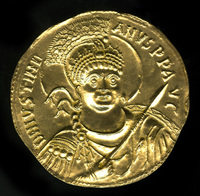Justinian medallion
Date:
534
Location or Findspot (Modern-Day Country):
Turkey
Medium:
Gold
Dimensions:
8.5 cm diam.
Description:
A unique Byzantine medallion was found in central Asia Minor in the mid-eighteenth century. It depicts on the obverse the beardless emperor Justinian I (r. 527–65) holding a spear and wearing a feathered headdress (the toupha). On the reverse, the same figure is being led on horseback by a winged Victory personification. The obverse inscription says, in Latin, "Our lord Justinian, eternal Augustus"; the reverse says "Salvation and glory of the Romans." The legend CONOB at the bottom is the abbreviation for Constantinople, where the piece was minted.
In the sixth century, Latin—not Greek—was still the language of the Byzantine court and the army, and the Byzantines continued to call themselves "Romans" for centuries. The medallion likely commemorated the victory of Justinian's general Belisarios over the Vandals in North Africa in 534. This event was also celebrated with the erection in Constantinople of a bronze image of a toupha-wearing figure on horseback atop a tall column. This imposing monument, which survived until 1453, was the tallest freestanding column in the premodern world and also the largest equestrian sculpture (superseded by an image of Louis XIV only in 1699). The gold medallion was not as large, but it was nevertheless impressive: it weighed over 162 grams, equal to 36 solidi. It was stolen from the French royal collection in 1831; the reproduction shown here was made from a sulphur cast of the original.
In the sixth century, Latin—not Greek—was still the language of the Byzantine court and the army, and the Byzantines continued to call themselves "Romans" for centuries. The medallion likely commemorated the victory of Justinian's general Belisarios over the Vandals in North Africa in 534. This event was also celebrated with the erection in Constantinople of a bronze image of a toupha-wearing figure on horseback atop a tall column. This imposing monument, which survived until 1453, was the tallest freestanding column in the premodern world and also the largest equestrian sculpture (superseded by an image of Louis XIV only in 1699). The gold medallion was not as large, but it was nevertheless impressive: it weighed over 162 grams, equal to 36 solidi. It was stolen from the French royal collection in 1831; the reproduction shown here was made from a sulphur cast of the original.
Relevant Textbook Chapter(s):
3
Repository and Online Resources:
• Read about this object (B.11501) on the British Museum website.
Image Credits:
British Museum; Wikimedia Commons




